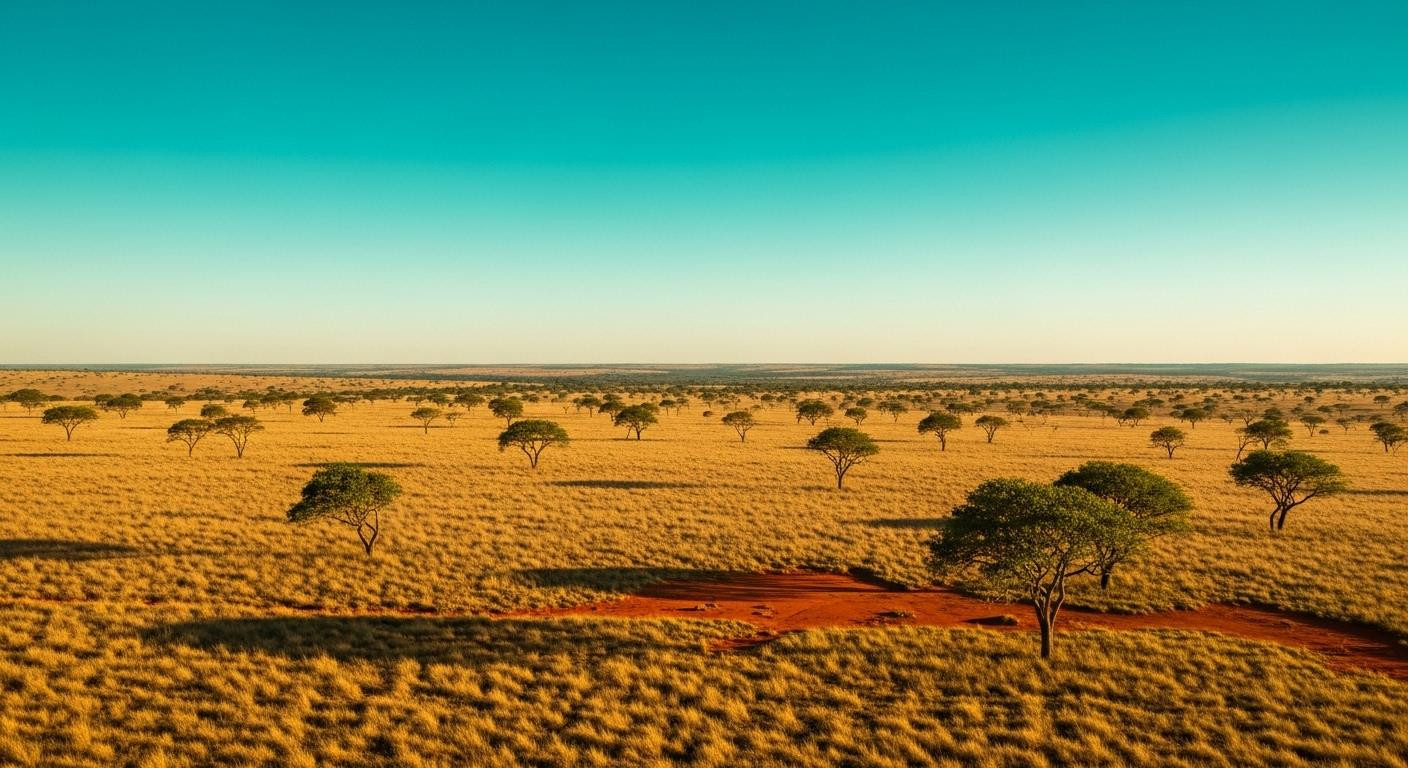Dawn breaks at 6:47 AM over Chapada dos Veadeiros National Park. Golden light touches twisted trees across endless savannah while a maned wolf pauses at the gallery forest edge. Steam rises from your coffee at an $80 eco-lodge – half what Pantanal lodges charge, a fraction of African safari costs. While 2 million chase wetland jaguars and Serengeti lions, the Cerrado receives just 70,000 visitors annually. This is the world’s richest savannah, hiding 10,000 plant species across 21% of Brazil, crowned by UNESCO heritage and a futuristic capital most travelers never consider.
Neither Pantanal wetlands nor Serengeti plains
The Cerrado sprawls across central Brazil’s heart – 735,000 square miles of tropical savannah spanning Goiás, Mato Grosso, and Minas Gerais states. Unlike the Pantanal’s flooded plains focused on aquatic wildlife, or Africa’s big-game herds roaming luxury lodge circuits, this ecosystem offers a different rhythm entirely.
The landscape shifts from Brasília’s modernist geometry to organic wilderness in 3.5 hours. Twisted schizolobium trees dot golden grasslands where gallery forests line permanent waterways. Rocky mesas rise to 5,250 feet elevation while cascading streams create hidden waterfalls throughout Chapada dos Veadeiros.
First impressions matter here. You land at Brasília’s futuristic airport, rent a car for $35 daily, and drive through changing landscapes. The transition feels complete when concrete gives way to the world’s second-largest biome in South America.
The world’s richest savannah nobody talks about
10,000 plant species in golden silence
The Cerrado defies safari expectations with flora diversity surpassing famous destinations. These golden grasslands harbor more plant species than African savannahs, yet receive 96% fewer visitors than Kenya’s Maasai Mara. Endemic pequi fruit trees and lobeira bushes thrive in reddish-orange soil under endless blue skies.
UNESCO recognized Chapada dos Veadeiros in 2001 for precisely this overlooked biodiversity. The aesthetic strikes visitors immediately: gallery forests creating micro-ecosystems within savannah matrix, waterfalls hidden in rocky formations, and panoramic vistas at sunrise.
Maned wolves and 200 mammals you’ve never heard of
Wildlife encounters differ from safari expectations entirely. The elusive maned wolf appears red-orange and fox-like, roaming solitary territories at dusk. Giant anteaters, capybaras, and nine-banded armadillos call this home alongside 200 mammal species, many endemic to the region.
Hyacinth macaws paint blue streaks across dawn skies while toucans announce morning from gallery forest edges. Local folklore describes maned wolves’ mystical powers – visitors often spot these creatures during early morning walks. Not Africa’s “Big Five,” but equally compelling wildlife that thrives in protective obscurity.
What $80 buys in Cerrado vs $400 in Pantanal
Eco-lodges, gallery forest hikes, and dawn wildlife watching
A typical day begins with 6:30 AM guided walks through gallery forests ($50-100 daily). Mid-range eco-lodges charge $80-150 nightly versus Pantanal’s $200-400 rates. National park entrance fees cost $10-25 compared to African safari gates at $50 minimum.
Activities focus on waterfall hikes in Chapada dos Veadeiros, birdwatching for macaws and toucans, and sunset savannah drives. Trails accommodate 3-5 hikers maximum while sunrise viewpoints offer complete solitude. The unhurried pace transforms travel expectations entirely.
Brasília’s modernist shock and regional cuisine
The architectural contrast surprises everyone. Oscar Niemeyer’s Cathedral and brutalist government buildings create geometric perfection against organic wilderness backgrounds. This fusion of futuristic urbanism and indigenous-colonial cuisine defines the Cerrado experience uniquely.
Local restaurants serve pequi fruit dishes, carne de sol, and pamonha for $5-15 meals. Markets display cassava, game meats, and native ingredients unknown elsewhere. Budget-conscious travelers discover authentic flavors without tourist markup pricing.
When silence replaces safari crowds
The atmospheric difference becomes clear immediately: no safari vehicle queues, no luxury lodge competition, no Instagram hordes at viewpoints. Just 70,000 annual visitors across 735,000 square miles means dawn encounters feel deeply personal.
Recent visitor surveys reveal consistent themes: “timeless,” “nature untouched,” “unhurried pace.” The comparison crystallizes quickly – Pantanal’s 2 million visitors and African safari commercialization versus Cerrado’s protective obscurity. The irony persists: the world’s richest savannah remains South America’s best-kept secret while lesser ecosystems dominate travel guides.
Your questions about Cerrado, Brazil: preserving South America’s great savannah answered
When should I visit to avoid crowds and see wildlife?
May-September dry season offers optimal conditions with 59-72°F temperatures, minimal rain, and enhanced wildlife visibility. November-March rainy season provides lush vegetation but fewer animal sightings. Peak ecotourism during winter months still means relative solitude compared to other destinations. Book eco-lodges 2-3 months ahead during dry season for best selection.
How does Cerrado access compare to Pantanal or African safaris?
Brasília International Airport connects to São Paulo and Rio, then requires 3.5-hour drives to Chapada dos Veadeiros. Round-trip flights from the U.S. average $800-1,200 versus $1,500 minimum for African safari hubs. Rental cars prove necessary with generally good roads. No guided vehicle requirements like African parks allow independent exploration with basic Portuguese and park maps.
What makes Cerrado’s biodiversity “richer” than African savannahs?
The Cerrado contains 10,000 plant species versus Africa’s 3,000-5,000 savannah species. This ancient geological stability spanning millions of undisturbed years allowed extreme speciation. Gallery forests create unique ecological complexity within savannah matrix – biodiversity patterns not found in African grasslands. UNESCO recognition confirms these scientific metrics supporting world’s richest savannah designation.
Steam dissipates from your morning coffee as golden light floods Chapada dos Veadeiros’ valleys. A hyacinth macaw crosses overhead, vivid blue against amber grass. No safari vehicle dust, no crowded lodges – just the world’s richest savannah whispering what 2 million annual visitors never hear: Brazil’s true wilderness hides in plain sight.
